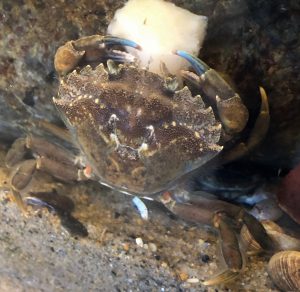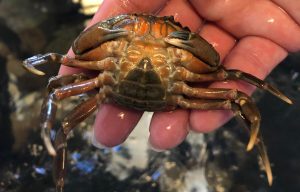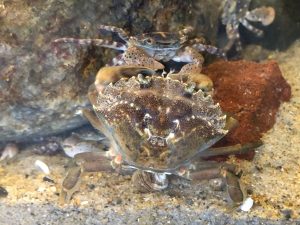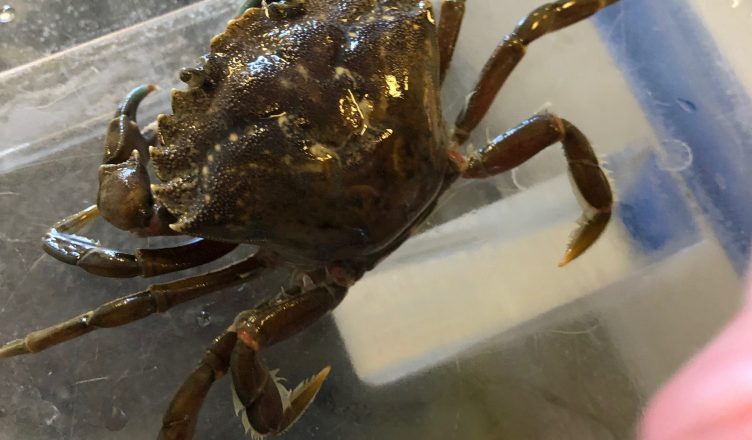This is part of our series about different animals and events at our Blue Ocean Discovery Center . This month we will discuss a Discovery Center inhabitant: the green crab.
Visitors to the Discovery Center can observe green crabs in our observation tanks. We don’t put them in the large touch tank because they are very ferocious and we don’t want anyone to be pinched by these aggressive crabs and then shy away from interacting with the marine world in the future. Children often find the crabs among the rocks on Hampton Beach and it is important to handle them carefully. The best way to pick them up is to gently pinch each side of the shell or carapace so that the crab’s claws can’t do any damage.
Identifying a Green Crab
Green crabs are not always green! They may be mottled green with yellow flecks, but also may be brown, orange or red. The best way to identify a green crab is to ignore the color and look for five spines on the shell between the eye and the corner of the carapace and three rounded lobes between the eyes. They have four pairs of walking legs and move sideways……quickly. In our area adult green crab carapaces are usually 2-3 inches wide, making them larger than an Asian shore crab but smaller than Jonah and rock crabs.


Here’s a fun fact: crabs must walk sideways because they do not have a ball and socket joint attaching their leg to their body that would allow them to swing their legs to the front and back like we (and other front walkers) do.
A Successful Invasive Species
In a previous post, we discussed the invasive Asian shore crab, and the green crab is also an invasive species to North America, having been described as among the 100 “world’s worst alien invasive species”. Green crabs are native to the European Atlantic Ocean and Baltic Sea and made their way to Massachusetts aboard a sailing ship in 1817. They now live on the east coast of North America from South Carolina to Newfoundland as well as in many other parts of the world. A successful invading species needs to be able to live under many conditions and have a varied diet and the green crab is a perfect example. It can live in all types of marine habitats and substrates including mud, sand, and rocks. It tolerates varying salinities and temperatures as well.
Female crabs produce one or two clutches of eggs a year with 180,000 eggs in each clutch. The crab is a fierce predator eating bivalves, worms and other crustaceans. They can dig down six inches in the sand to find clams and one crab can eat forty clams or mussels a day. The soft shell clam fishery in New England has been decimated by the green crab.

Predators and Humans
The green crab has few predators. Gulls and fish eat them and they are caught for bait; but not in numbers that significantly decrease the population. Gabby Bradt, a fisheries specialist with UNH Cooperative Extension and NH Sea Grant, is studying the green crab with hopes of getting people to eat them in an attempt to greatly reduce their numbers. The crab’s hard shell makes it difficult to get the meat out of them but local chefs have been successful in cooking them whole to create a stock that is used in soups, stews, risotto and paella. Bradt hopes to be able to predict when the crabs will molt and then they can be harvested when they have a soft shell and can be more easily eaten. Look for green crabs on local menus and you can help the environment be enjoying the tasty treat!
Learn More:





